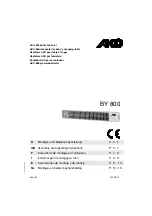
Combustion and ventilation air requirements are deter-
mined by where the water heater is to be located.
Water heaters are installed in either open (unconfined)
spaces or smaller (confined) spaces, such as closets
or small rooms.
Requirements for Unconfined Spaces
An unconfined space is an area with at least 50 cubic
feet for each 1,000 BTUH (4.8 m
3
/kW) of the total
input rating for all gas appliances installed in that
space. Water heaters installed in unconfined spaces
do not usually require outdoor air to function properly.
However, in buildings with tight construction (heavy
insulation, vapour barriers, weather stripping, etc.),
and particularly in modern buildings, additional fresh
air may need to be provided. For instructions on
obtaining additional air supply, see the requirements
below for confined spaces.
Requirements for Confined Spaces
A confined space is an area where the volume is less
than 50 cubic feet for each 1,000 BTUH (4.8 m
3
/kW) of
the total input rating for all gas appliances installed in
that space. Water heaters installed in confined spaces
require additional air. This can be provided in two ways:
In Canada (refer to CAN/CSA B149.1)
1)
All Air From Inside the Building (
see Figure 2
):
The confined space shall be provided with
one opening of one (1) square inch per 1,000 BTUH
(22.0 cm
2
/kW) communicating directly with one or
more rooms of sufficient volume, so that the com-
bined volume of all spaces meets the criteria for an
unconfined space for all the appliances installed in
that confined space.
2)
All Air From Outdoors: (
see Figure 3
):
An air-supply shall be provided with one opening that
communicates directly with the outdoors by means of
a duct. This duct shall be sized according to CAN/CSA
B149.1 and terminate within one (1) foot above and
within two (2) feet horizontally from the burner level of
the appliance having the largest input.
In U.S.A. (refer to ANSI Z223.1/NFPA 54)
1)
All Air From Inside the Building (
see Figure 4
):
The confined space shall be provided with two per-
manent openings communicating directly with one or
more rooms of sufficient volume, so that the combined
volume of all spaces meets the criteria for an uncon-
fined space. The total input rating of all gas appliances
installed in the combined space shall be considered in
making this determination.
Each opening shall have a minimum free area of one
(1) square inch per 1,000 BTUH (22.0 cm
2
/kW) of the
total input rating of all gas appliances in the confined
space,
but not less than
100 square inches (645,16
cm
2
). One opening shall commence within six (6) inches
(15.2 cm) of the top and one within six (6) inches (15.2
cm) of the bottom of the enclosure.
2)
All Air From Outdoors:
The confined space shall be provided with two perma-
nent openings, one commencing within six (6) inches
(15.2 cm) of the top and one commencing within six (6)
inches (15.2 cm) from the bottom of the enclosure.
The openings shall communicate directly or by ducts,
with the outdoors or spaces (crawl or attic) that freely
communicate with the outdoors.
5
INSTALLATION INSTRUCTIONS
Confined Space
Inlet air duct
18''
24''
Confined Space
Permanent
Opening
--------------
1 square inches /
1,000 BTUH
Figure 3
Figure 2
Espace confiné
Conduite
d’entrée d’air
18''
24''
--------------
Illustration 3
Illustration 2
Espace confiné
Ouverture
permanente
1 pouce carré /
1000 BTUH
Figure 2
Confined Space
Inlet air duct
18''
24''
Confined Space
Permanent
Opening
--------------
1 square inches /
1,000 BTUH
Figure 3
Figure 2
Espace confiné
Conduite
d’entrée d’air
18''
24''
--------------
Illustration 3
Illustration 2
Espace confiné
Ouverture
permanente
1 pouce carré /
1000 BTUH
Figure 3
Espace restreint
Évent menant
à l’extérieur
Évent menant
à l’extérieur
Entrée d’air du
sous-sol
Évent de fondation
Sortie d’air au grenier
Sortie d’air au grenier
Conduite d’air extérieur
Sortie
Entrée
Conduite d’entrée d’air
Espace
restreint
Espace
restreint
Espace
restreint
Installez
au dessus
de l’isolation
Ouverture
permanente
po
po
po
po
po
po
po
po
Figure 4






































